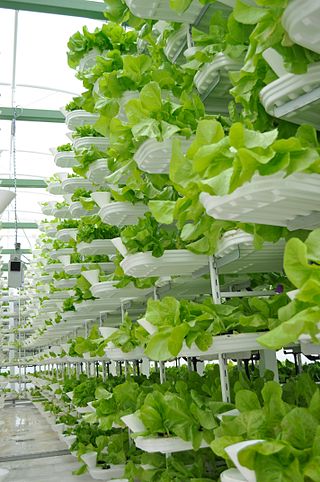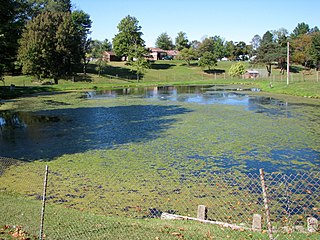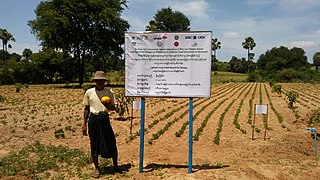Related Research Articles

Desertification is a type of gradual land degradation of fertile land into arid desert due to a combination of natural processes and human activities.

In genetics, the phenotype is the set of observable characteristics or traits of an organism. The term covers the organism's morphology, its developmental processes, its biochemical and physiological properties, its behavior, and the products of behavior. An organism's phenotype results from two basic factors: the expression of an organism's genetic code and the influence of environmental factors. Both factors may interact, further affecting the phenotype. When two or more clearly different phenotypes exist in the same population of a species, the species is called polymorphic. A well-documented example of polymorphism is Labrador Retriever coloring; while the coat color depends on many genes, it is clearly seen in the environment as yellow, black, and brown. Richard Dawkins in 1978 and then again in his 1982 book The Extended Phenotype suggested that one can regard bird nests and other built structures such as caddisfly larva cases and beaver dams as "extended phenotypes".

Sustainable agriculture is farming in sustainable ways meeting society's present food and textile needs, without compromising the ability for current or future generations to meet their needs. It can be based on an understanding of ecosystem services. There are many methods to increase the sustainability of agriculture. When developing agriculture within sustainable food systems, it is important to develop flexible business processes and farming practices. Agriculture has an enormous environmental footprint, playing a significant role in causing climate change, water scarcity, water pollution, land degradation, deforestation and other processes; it is simultaneously causing environmental changes and being impacted by these changes. Sustainable agriculture consists of environment friendly methods of farming that allow the production of crops or livestock without causing damage to human or natural systems. It involves preventing adverse effects on soil, water, biodiversity, and surrounding or downstream resources, as well as to those working or living on the farm or in neighboring areas. Elements of sustainable agriculture can include permaculture, agroforestry, mixed farming, multiple cropping, and crop rotation.

The MIT Media Lab is a research laboratory at the Massachusetts Institute of Technology, growing out of MIT's Architecture Machine Group in the School of Architecture. Its research does not restrict to fixed academic disciplines, but draws from technology, media, science, art, and design. As of 2014, Media lab's research groups include fetus, biologically inspired fabrication, socially engaging robots, emotive computing, bionics, and hyperinstruments.

Urban agriculture refers to various practices of cultivating, processing, and distributing food in urban areas. The term also applies to the area activities of animal husbandry, aquaculture, beekeeping, and horticulture in an urban context. Urban agriculture is distinguished from peri-urban agriculture, which takes place in rural areas at the edge of suburbs.

Parthenium argentatum, commonly known as the guayule, is a perennial woody shrub in the family Asteraceae that is native to the rangeland area of the Chihuahuan Desert; including the southwestern United States and northern Mexico. It was first documented by J.M. Bigelow in 1852 through the Mexican Boundary Survey and was first described by Asa Gray. Natural rubber, ethanol, non-toxic adhesives, and other specialty chemicals can be extracted from guayule. An alternative source of latex that is hypoallergenic, unlike the normal Hevea rubber, can also be extracted. While Castilla elastica was the most widely used rubber source of Mesoamericans in pre-Columbian times, guayule was also used, though less frequently. The name "guayule" derives from the Nahuatl word ulli/olli, "rubber".

A fab lab is a small-scale workshop offering (personal) digital fabrication.

Vertical farming is the practice of growing crops in vertically and horizontally stacked layers. It often incorporates controlled-environment agriculture, which aims to optimize plant growth, and soilless farming techniques such as hydroponics, aquaponics, and aeroponics. Some common choices of structures to house vertical farming systems include buildings, shipping containers, underground tunnels, and abandoned mine shafts.

Algal nutrient solutions are made up of a mixture of chemical salts and seawater. Sometimes referred to as "Growth Media", nutrient solutions, provide the materials needed for algae to grow. Nutrient solutions, as opposed to fertilizers, are designed specifically for use in aquatic environments and their composition is much more precise. In a unified system, algal biomass can be collected by utilizing carbon dioxide emanating from power plants and wastewater discharged by both industrial and domestic sources. This approach allows for the concurrent exploitation of the microalgae's capabilities in both carbon dioxide fixation and wastewater treatment. Algae, macroalgae, and microalgae hold promise in addressing critical global challenges. Sustainable development goals can be advanced through algae-based solutions, to promote a healthy global ecosystem.
Controlled-environment agriculture (CEA) -- which includes indoor agriculture (IA) and vertical farming—is a technology-based approach toward food production. The aim of CEA is to provide protection from the outdoor elements and maintain optimal growing conditions throughout the development of the crop. Production takes place within an enclosed growing structure such as a greenhouse or plant factory.

The Ministry of Agriculture and Land Reclamation of Egypt is a ministerial body in charge of agriculture and land reclamation in Egypt.
The environmental impact of agriculture is the effect that different farming practices have on the ecosystems around them, and how those effects can be traced back to those practices. The environmental impact of agriculture varies widely based on practices employed by farmers and by the scale of practice. Farming communities that try to reduce environmental impacts through modifying their practices will adopt sustainable agriculture practices. The negative impact of agriculture is an old issue that remains a concern even as experts design innovative means to reduce destruction and enhance eco-efficiency. Animal agriculture practices tend to be more environmentally destructive than agricultural practices focused on fruits, vegetables and other biomass. The emissions of ammonia from cattle waste continue to raise concerns over environmental pollution.

Agricultural machinery relates to the mechanical structures and devices used in farming or other agriculture. There are many types of such equipment, from hand tools and power tools to tractors and the farm implements that they tow or operate. Machinery is used in both organic and nonorganic farming. Especially since the advent of mechanised agriculture, agricultural machinery is an indispensable part of how the world is fed.

Foodscaping is a modern term for integrating edible plants into ornamental landscapes. It is also referred to as edible landscaping and has been described as a crossbreed between landscaping and farming. As an ideology, foodscaping aims to show that edible plants are not only consumable but can also be appreciated for their aesthetic qualities. Foodscaping spaces are seen as multi-functional landscapes that are visually attractive and also provide edible returns. Foodscaping is a method of providing fresh food affordably and sustainably.

Regenerative agriculture is a conservation and rehabilitation approach to food and farming systems. It focuses on topsoil regeneration, increasing biodiversity, improving the water cycle, enhancing ecosystem services, supporting biosequestration, increasing resilience to climate change, and strengthening the health and vitality of farm soil.

Indigo Agriculture is a Boston, Massachusetts-based agricultural technology company that works with plant microbes, aiming to improve yields of cotton, wheat, corn, soybeans, and rice. The company also offers crop storage and other logistics programs for farmers.

FarmBot is an open source precision agriculture CNC farming project consisting of a Cartesian coordinate robot farming machine, software and documentation including a farming data repository. The project aims to "Create an open and accessible technology aiding everyone to grow food and to grow food for everyone."

Carbon farming is a set of agricultural methods that aim to store carbon in the soil, crop roots, wood and leaves. The technical term for this is carbon sequestration. The overall goal of carbon farming is to create a net loss of carbon from the atmosphere. This is done by increasing the rate at which carbon is sequestered into soil and plant material. One option is to increase the soil's organic matter content. This can also aid plant growth, improve soil water retention capacity and reduce fertilizer use. Sustainable forest management is another tool that is used in carbon farming. Carbon farming is one component of climate-smart agriculture. It is also one way to remove carbon dioxide from the atmosphere.

Climate-smart agriculture (CSA) is a set of farming methods that has three main objectives with regards to climate change. Firstly, they use adaptation methods to respond to the effects of climate change on agriculture. Secondly, they aim to increase agricultural productivity and to ensure food security for a growing world population. Thirdly, they try to reduce greenhouse gas emissions from agriculture as much as possible. Climate-smart agriculture works as an integrated approach to managing land. This approach helps farmers to adapt their agricultural methods to the effects of climate change.

Elizabeth Anna Ainsworth is an American plant physiologist currently employed by the University of Illinois at Urbana-Champaign. She previously worked for the United States Department of Agriculture (USDA) Agricultural Research Service (ARS). She is a Fellow of the American Association for the Advancement of Science (AAAS) and was awarded the 2018 Crop Science Society of America Presidential Award. She is known for researching the effects of atmospheric pollutants, including ozone and carbon dioxide, on the productivity of selected major crops such as corn and soybeans.
References
- ↑ Matt McFarland (17 June 2015). "Inside an MIT researcher's grand plan to create the personal food computer". Washington Post.
- ↑ Cohen, Noam (25 October 2019). "Troubled M.I.T. Media Lab Food Project Closes, for Now". New York Times. Retrieved 2 April 2020.
- 1 2 Cohen, Noam (May 13, 2020). "M.I.T. Closes 'Food Computer' Project After Scientists Raised Doubts". The New York Times– via NYTimes.com.
- 1 2 "Group Overview ‹ Open Agriculture (OpenAg)". MIT Media Lab.
- 1 2 "OpenAg Initiative — Farming for the Future". mit.edu. Retrieved 2016-02-03.
- ↑ "MIT Built a Theranos for Plants". Gizmodo. 8 September 2019.
- ↑ Looper, Christian de (July 2, 2015). "The Personal Food Computer Is A Farm For Your Apartment". Tech Times.
- ↑ Nitya Rajan (5 Nov 2015). "Food Computer Set To Alleviate Global Food Crisis Using 'Climate Recipes'". www.huffingtonpost.co.uk.
- 1 2 Heather Hansman. "What Is a Personal Food Computer?". Smithsonian.
- ↑ "MIT Open Ag Project". Google Docs.
- ↑ "Food Computer Set To Alleviate Global Food Crisis Using 'Climate Recipes'". The Huffington Post UK. 5 November 2015. Retrieved 2016-02-03.
- ↑ "Food Computers".
- 1 2 "Food Computers". mit.edu. Retrieved 2016-02-03.
- ↑ "The Wikipedia Of Farming Is Here". Popular Science. 22 September 2015.
- ↑ "Now What With Ryan Duffy | AOL.com". on.aol.com.
- 1 2 "Build". mit.edu. Retrieved 2016-02-03.
- ↑ "Great Plant Escape - Growing plants indoors". web.extension.illinois.edu.
- ↑ "The Genotype/Phenotype Distinction". stanford.edu. 2021.
- ↑ "The Wikipedia Of Farming Is Here". Popular Science. 22 September 2015.
- ↑ Harper, Caleb; Siller, Mario (October 30, 2015). "OpenAG: A Globally Distributed Network of Food Computing". IEEE Pervasive Computing. 14 (4): 24–27. doi:10.1109/MPRV.2015.72. S2CID 1963859.
- ↑ "Corporate Research Partner - MIT Media Lab". mit.edu. Archived from the original on 2015-12-22. Retrieved 2015-11-06.
- ↑ "Member companies". MIT Media Lab.
- 1 2 "Team". mit.edu. Retrieved 2016-02-03.
- 1 2 Cohen, Noam (2019-09-22). "M.I.T. Media Lab, Already Rattled by the Epstein Scandal, Has a New Worry". The New York Times. ISSN 0362-4331 . Retrieved 2019-10-25.
- ↑ "MIT's Media Lab has an ambitious project that purports to revolutionize agriculture. Insiders say it's mostly smoke and mirrors". Business Insider. Retrieved 2019-10-25.
- ↑ "Hype vs. Reality at the MIT Media Lab". The Chronicle of Higher Education. 2019-09-11. Retrieved 2019-10-25.
- ↑ "How to grow food with a computer in Jordan | WFP Innovation". innovation.wfp.org. Retrieved 2019-10-25.
- ↑ "MIT Media Lab Scientist Used Syrian Refugees to Tout Food Computers That Didn't Work". IEEE Spectrum: Technology, Engineering, and Science News. Retrieved 2019-10-25.
- ↑ Lisa Song, Max Larkin (2019-09-20). "MIT Media Lab Kept Regulators in the Dark, Dumped Chemicals in Excess of Legal Limit". ProPublica. Retrieved 2019-10-25.
- ↑ "MassDEP Review 2019". Bates Research and Engineering Center. Massachusetts Institute of Technology. Retrieved 2020-06-02.